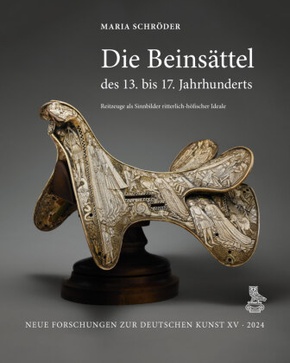
Die Beinsättel des 13. bis 17. Jahrhunderts - Reitzeuge als Sinnbilder ritterlich-höfischer Ideale
| Verlag | Deutscher Verlag für Kunstwissenschaft |
| Auflage | 2024 |
| Seiten | 458 |
| Format | 25,1 x 3,3 x 30,7 cm |
| Gewicht | 2603 g |
| Reihe | Neue Forschungen zur deutschen Kunst XV |
| ISBN-10 | 3871572675 |
| ISBN-13 | 9783871572678 |
| Bestell-Nr | 87157267A |
In Museen weltweit werden Sättel und Sattelfragmente des 13. bis 17. Jahrhunderts aufbewahrt, die durch prächtige oberflächendeckende Beinarbeiten faszinieren. Als Reitsitze scheinen sie aufgrund ihres detailreichen Dekors ungeeignet, aber zu welchem Zweck wurden sie dann gefertigt? Die Studie geht diesem Rätsel nach.
Spätmittelalterliche und frühneuzeitliche Sättel mit kunstvollen Schnitzereien und Gravuren in Knochen, Geweih und Elfenbein finden sich weltweit in zahlreichen musealen Sammlungen. Die Sättel wurden in der Regel zusammen mit Waffen und Rüstzeugen aus Leder und Metall ausgestellt. Angesichts ihres Dekors scheinen sie viel zu empfindlich, um tatsächlich als Reitsitze gebraucht worden zu sein. Maria Schröder ermittelt auf Grundlage umfassender Objektstudien und zeitgenössischer Text- und Bildquellen die ursprüngliche Bedeutung und Funktion der Beinsättel. Sie erweisen sich als Repräsentationsmedien der aristokratischen und später auch der bürgerlichen Elite. Die höfische Epik mit ihren literarischen Beschreibungen von Beinsätteln nimmt als Textquelle eine Schlüsselrolle ein.
The work focuses on a group of 37 splendid saddles and saddle-bows that can be found distributed throughout various European and North American museums. Usually exhibited alongside armour made from leather and metal, the saddles are remarkable for their light, shiny surfaces of elaborately carved and engraved bone and antler. These appliques make the saddles appear fragile, especially since their decoration would be concealed by a rider. Thus, despite the outer form, their functionality for riding must be called into question. Therefore, there was a need for fundamental research in which all objects were studied in detail and analysed in relation to contemporary textual and pictorial sources in order to determine, among other things, the original meaning and function of the bone-saddles. The work undertakes this task with the aim of placing the works in the context of their time and expanding our knowledge of Central European court culture. This approach has uncovered that the sad dles were a means of representation that embodied the ideals of chivalry and courtly life. They were associated with specific means of representation that were established by the courtly nobility and later adopted by the emerging bourgeoisie. These findings lend a new relevance to the study of riding equipment, a field which has remained largely unnoticed by research, although the horse was of unparalleled importance within the society of the time. The chosen methodological approach, which combines art-historical, historical and literary techniques and research, means that the work is also of value to the study of ivories, early material culture, material-semantic object studies and the literary study of the courtly epic. The latter took on a key role within the work as a textual source, not least in analysing the connection and conditionality between literary descriptions of bone-saddles and their real counterparts.
